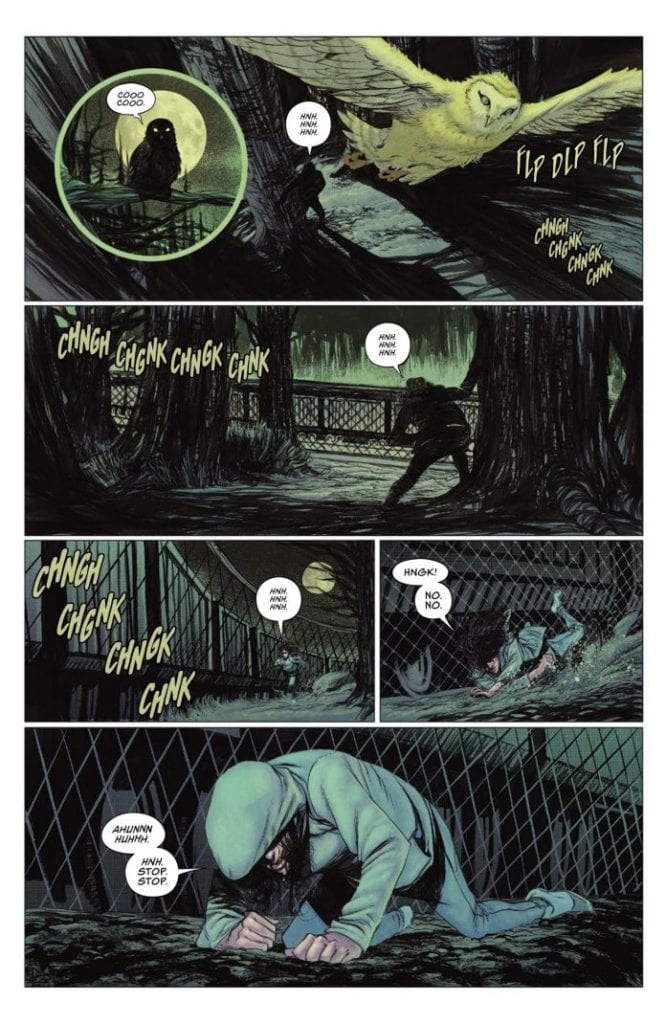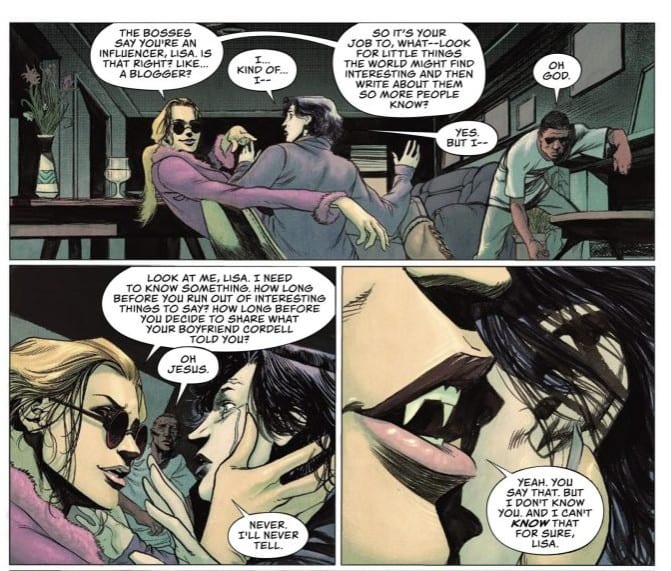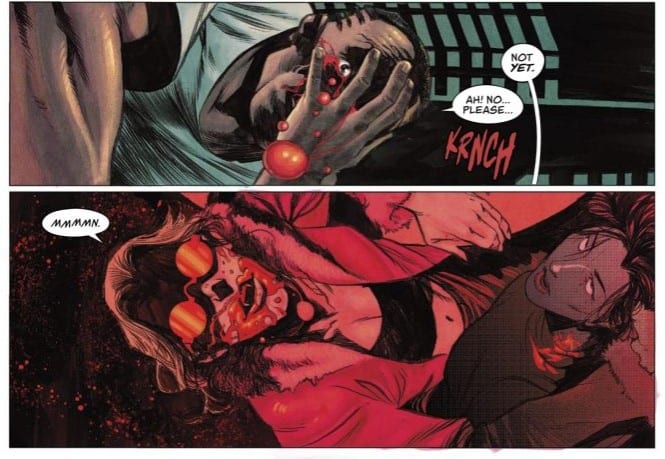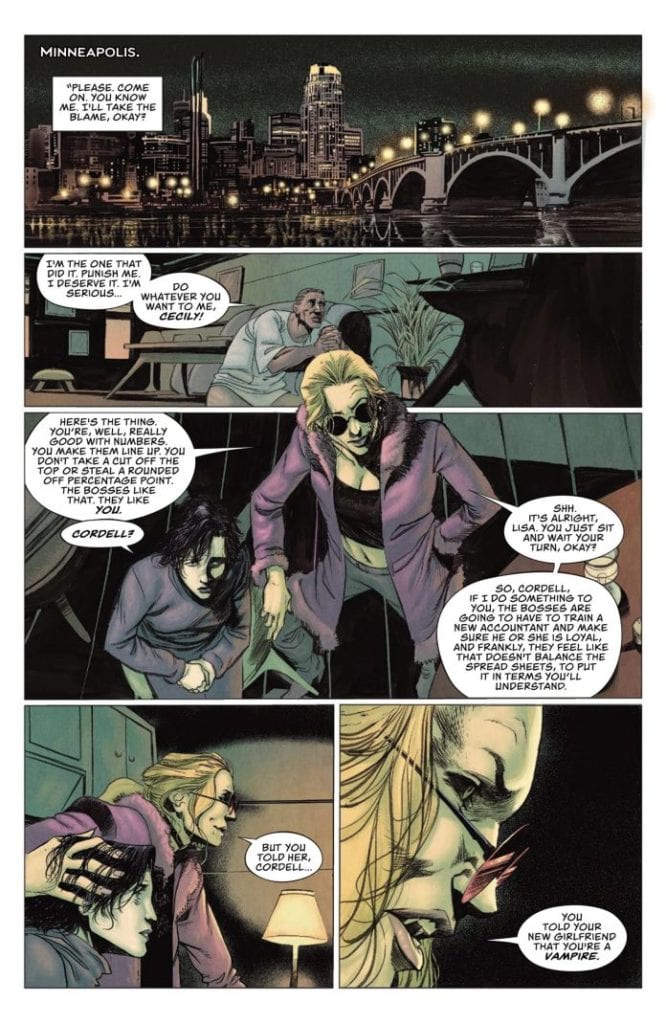Role playing games have, on occasion, been the source for works of fiction, take the George R. R. Martin line of books Wild Cards as an example. A series of books that first appeared in 1987 and new releases are still coming out. Dungeons and Dragons is growing in popularity again and feeding back into geek culture: Kieron Gillen and Stephanie Hans’ Die from Image comics is a modern, dark fantasy set firmly in the world of D&D.
It will come as no surprise, then, that another popular role playing game would make it’s leap into the realms of comic book storytelling. Vault Comics newest title, Vampire The Masquerade, takes the complex hierarchical vampire society from the game and imposes it onto a very modern world. The comic features the start of two tales, each featuring a female lead from a different caste of vampire.

Feeding Frenzy
Vampire The Masquerade, the game, was created in 1991 by Mart Rein-Hagan and was set amongst a society of undead, all struggling to survive in the modern world. One of the main premises behind the role playing game was that the vampires were working behind the scenes, hidden from society. It switched the players from being hunters of evil creatures to often misunderstood demons, scratching out an existence. Ultimately it’s Anne Rice’s Vampire Chronicles in game form.
In the main feature of the comic, Winter’s Teeth, Tim Seeley and Devmalya Pramanik introduce the readers to Cecily, a violent vampire enforcer. She is shown to be a cruel, almost heartless, monster in her opening scene but Seeley and Pramanik also manage to make her sympathetic. Maybe this is because they dress her in a Duran Duran t-shirt; a reference to a band that has been linked with a number of modern vampire tales.
The musical theme is carried through the scene with Cecily singing a traditional German song that became popular in America in the early 19th Century. This reference infers the timelessness of the vampire, hinting at her age, whereas the Duran Duran reference indicates that she is still a part of modern society. Whereas some vampires are removed from the modern world, Cecily is shown to take an interest in it.
As the story progresses Seeley uses Cecily to lead the reader into the world of Vampire The Masquerade. Through her the complex society of the undead is revealed and with it the indications that a clan war is on the horizon. This is where Seeley digs deep into the myths of the role playing game and draws out elements gamers will find familiar. This does not, however, impede the storytelling. Seeley is clever enough to weave the game elements into the fabric of his story without them standing out like a punk rock patch on a 17th Century courtesan dress.

Vampire Tropes
Stories involving Vampires go through waves of popularity, with each crest containing a mass of unoriginal undead tales and a few experimental genre twisters. The success of each often depends on the audience it is aimed at. Twilight for example was extremely popular for a short time, de-fanging the vampire and turning the demon into a cute puppy for teenage girls. But there have always been more violent, horror focused alternatives, especially in comics books. Titles like 30 Days of Night and American Vampire are more fierce with an emphasis on the bestial nature of the undead beast.
With Pramanik’s visuals, Vampire The Masquerade falls somewhere between the two extremes. He mixes the precise outlines of characters with scratchy, pitch black shadows that devour the scenery like the bloodthirsty creatures he draws. There is an eloquence to the cast that is bathed in violence and abstract horror. Some of the panels capture the sublime beauty that made Bram Stoker’s original novel, Dracula, such a classic.
As you move through the story you begin to get a sense of what it is to be one of these lost creatures of the night. This is the comics greatest strength and is more impressive than the story itself. The emotional impact outweighs the blend of vampire mythologies that form the basis of The Masquerade’s role playing attraction. Here, Seeley and Pramanik are more concerned with telling an engaging story than they are feeding fans of the game franchise.

The Anarch Tales
The second tale in the comic is written by Tini Howard and Blake Howard and focuses on the outcasts of the Vampire Society. A group of misfits, led by Colleen Pendergrass, etch out a living, sourcing blood wherever they can get it. Colleen was part of an abusive relationship before being sired by her husband, itself an act of abuse, and continues to live in such a world. Her husband, Mitch, is tellingly introduced to the reader in his canine form. There is no subtlety in the characterisation in this chapter of the comic.
This element of the comic starts off like an episode of What We Do In The Shadows but without the humour. The Howard’s introduce an array of creatures, each a deformed stereotype but, just like the preceding story, there is a charm to the way the tale is told. Surprisingly, the cliches don’t grate and the intrigue inherent in the story doesn’t allow you to question what you are reading.
Nathan Gooden’s freer art style gives the pages a lot of momentum. The story feels as though it has a fast pace even though not a lot actually happens. His characters have a clear definition but the setting is more of an emotional construct; an idea of a place as opposed to an actual location. Above all else Gooden’s design has a much needed element of fun.
Linking the two stories together is the color work by Addison Duke and the lettering by Andworld Design. Both of these elements are consistent throughout the comic helping to create a single believable world for the characters to inhabit. Duke darkens the backgrounds but uses brighter, solid colors to make the characters pop from the page. He gives them an otherworldly appearance in a murky, realistic landscape. Andworld Design gives the vampires presence on the page, with subtle alterations to the text to emphasise verbal inflections. The lettering enforces the powerful nature of the vampires by placing their speech balloons over those of the humans.

Conclusion
Vampires seem to be making a bit of a comeback, at least in comic books. Later this year Image releases Dracula, Motherf**ker by Alex De Campi and Erica Henderson which is a more experimental take on the vampire genre. Vampire The Masquerade is a more traditional vision of the undead and plays into the history and mythology of vampirism. Just like the role playing game, it draws inspiration from many places; movies, novels, folklore.
The two tales contain elements of the role playing that will be recognisable to those familiar with it but in neither does this hamper the storytelling. Ultimately this feels like an excuse by Vault to tell some modern vampire tales and the creators do a good job. A title like this does have a limited appeal. If you have no interest in vampires then this comic isn’t for you as it doesn’t offer much beyond the thirst for drinking of blood. However, if you enjoy a bit of horror, and like grown up vampire stories, then Vampire The Masquerade should be right up your street.

